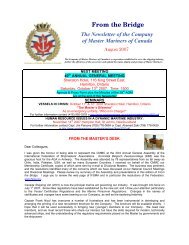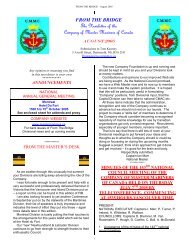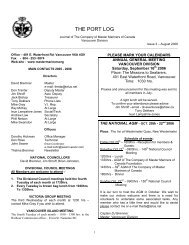Diversity in the Maritime Sector- The benefits of Cross Cultural ...
Diversity in the Maritime Sector- The benefits of Cross Cultural ...
Diversity in the Maritime Sector- The benefits of Cross Cultural ...
Create successful ePaper yourself
Turn your PDF publications into a flip-book with our unique Google optimized e-Paper software.
<strong>Diversity</strong> <strong>in</strong> <strong>the</strong> <strong>Maritime</strong> <strong>Sector</strong>-<br />
<strong>The</strong> <strong>benefits</strong> <strong>of</strong> <strong>Cross</strong> <strong>Cultural</strong> Tra<strong>in</strong><strong>in</strong>g<br />
Kelly Moret<br />
MI International<br />
September 29, 2010
Overview <strong>of</strong> Culture <strong>in</strong> <strong>the</strong> <strong>Maritime</strong> <strong>Sector</strong><br />
• 80% <strong>of</strong> <strong>in</strong>ternational trade; higher % develop<strong>in</strong>g countries<br />
• Most seafarers come from “labor supply<strong>in</strong>g countries”<br />
• 65% <strong>of</strong> <strong>the</strong> world merchant fleet use multi-national crews<br />
• Over 10% <strong>of</strong> fleet staffed with crews composed <strong>of</strong> 5+ nationalities<br />
• Social <strong>in</strong>tegration <strong>in</strong>creases with number <strong>of</strong> nationalities <strong>in</strong> crew<br />
“Ships with mult<strong>in</strong>ational<br />
crews function as m<strong>in</strong>iature<br />
mult<strong>in</strong>ational societies with<br />
all <strong>the</strong> attendant problems<br />
with communication and<br />
racial tension”
Overview <strong>of</strong> Culture <strong>in</strong> <strong>the</strong> <strong>Maritime</strong> <strong>Sector</strong><br />
• Management must take <strong>in</strong>to consideration dynamic and<br />
cont<strong>in</strong>uous changes while solv<strong>in</strong>g cultural identify issues<br />
• Issues will impact<br />
–Productivity<br />
–Work Activity<br />
–Crew Cohesion<br />
–Alienation/Isolation<br />
–Communication<br />
–SAFETY
How does culture impact work<br />
Negative:<br />
i. Loss <strong>of</strong> cultural contact<br />
ii. Alienation, Social isolation (safety)<br />
iii. Discrim<strong>in</strong>ation- affect<strong>in</strong>g social and work<strong>in</strong>g relations<br />
iv. L<strong>in</strong>guistic identify issues<br />
v. Communication (risk/safety)<br />
Good:<br />
i. Promotion <strong>of</strong> idea shar<strong>in</strong>g/creative problem solv<strong>in</strong>g<br />
ii. Social <strong>in</strong>teraction, diversity helps not h<strong>in</strong>ders teamwork<br />
“<strong>Cultural</strong> identity might be <strong>in</strong>fluenced by community<br />
size, cultural values, language, religion,<br />
communications and social networks”
What is culture<br />
Underly<strong>in</strong>g Values and Assumptions <strong>of</strong> a Society<br />
Visible<br />
-observable<br />
concrete<br />
Invisible<br />
-assumed<br />
-suspected
Visible<br />
• Observable, concrete parts <strong>of</strong> culture<br />
• Food clo<strong>the</strong>s, music, games, holiday traditions
Behaviour<br />
• Social Behavior, Gender Roles, Family Structure<br />
• Religion, Hierarchy<br />
• We l<strong>in</strong>k values to behaviors, symbols<br />
• Attach emotions to perceived values
Culture <strong>in</strong> <strong>the</strong> Workplace<br />
Dimensions <strong>of</strong> <strong>Cultural</strong> Difference<br />
• Individual or Group (<strong>in</strong>dividualism versus collectivism)<br />
• View <strong>of</strong> Power or Authority (hierarchy versus equality)<br />
• Concern with Protocol (formality versus <strong>in</strong>formality)<br />
• Rules or Relationships (rules prevail versus relationships)<br />
• Time (l<strong>in</strong>ear versus cyclical)<br />
• Sense <strong>of</strong> Personal Space (low versus high)
Personal Space and Physical Contact
Culture <strong>in</strong> <strong>the</strong> Workplace<br />
dimensions <strong>of</strong> cultural differences<br />
• Concept <strong>of</strong> power and power distance- is an attitude towards<br />
power, <strong>in</strong>equality and attitude (High versus low)<br />
• Attitude towards uncerta<strong>in</strong>ty and <strong>the</strong> unknown<br />
• <strong>The</strong> Concept <strong>of</strong> Status (Achieved versus ascribed)
Culture <strong>in</strong> <strong>the</strong> Workplace<br />
Dimensions <strong>of</strong> <strong>Cultural</strong> Difference<br />
• Communication- beyond <strong>the</strong> language barrier<br />
– Implicit versus explicit<br />
– Direct (low) context versus Indirect (high) context<br />
– Non-Verbal Communication<br />
» Gestures<br />
» Eye Contact<br />
» Conversational Style<br />
Para-verbal- 55%, body language- 38%, words- 7%
<strong>Cross</strong>-<strong>Cultural</strong> Communication<br />
• <strong>The</strong> send<strong>in</strong>g and receiv<strong>in</strong>g <strong>of</strong> messages is an <strong>in</strong>tegral part <strong>of</strong><br />
culture<br />
• In cross-cultural context <strong>in</strong>terpretation is more complicated<br />
• Messages sent and received are done so through cultural<br />
context and filters<br />
• Problems created by poor communication
<strong>Cultural</strong> Context<br />
My<br />
Idea<br />
My<br />
filters<br />
My<br />
Message<br />
O<strong>the</strong>r<br />
persons<br />
Filters<br />
O<strong>the</strong>r persons<br />
understand<strong>in</strong>g<br />
Filters<br />
FEEDBACK<br />
Source- Centre for Intercultural Learn<strong>in</strong>g
Language<br />
• Speak<strong>in</strong>g <strong>the</strong> same language does not mean that<br />
understand<strong>in</strong>g/communication has taken place or<br />
that <strong>the</strong>re is an understand<strong>in</strong>g <strong>of</strong> culture<br />
• Practice be<strong>in</strong>g active listeners; Use communication<br />
techniques until both parties are <strong>in</strong> agreement
In <strong>the</strong> context <strong>of</strong> <strong>the</strong> workplace……
Culture Shock- Adjust<strong>in</strong>g to a New Environment<br />
• Liv<strong>in</strong>g with room mates<br />
• Sense <strong>of</strong> Isolation<br />
• Language barriers<br />
• Time Management<br />
• Social time<br />
• Distribution <strong>of</strong> work, new rout<strong>in</strong>es<br />
• Food Rituals
Honeymoon<br />
Stage<br />
Initial enthusiasm<br />
Positive attitude<br />
Energy,<br />
Excitement<br />
Culture Shock Recovery Stage Adjustment Stage<br />
Discouraged,<br />
Homesick,<br />
Tired, Negative,<br />
Angry, Sick, Confused<br />
Bored, Scared,<br />
Frustrated<br />
Reactive Strategies<br />
Fight, Flight<br />
(withdrawal, isolation)<br />
Drugs, alcohol<br />
Source- Centre for Intercultural Learn<strong>in</strong>g<br />
Interested <strong>in</strong> work,<br />
Ask questions,<br />
Rout<strong>in</strong>es<br />
Sense <strong>of</strong> humour,<br />
Less judgmental, Feel<br />
useful<br />
Proactive Strategies<br />
Assertiveness,<br />
Strategic step back,<br />
Intercultural<br />
communication<br />
More adventurous,<br />
Seek new<br />
opportunities,<br />
Feel motivated,<br />
Seek company <strong>of</strong><br />
o<strong>the</strong>rs,<br />
Acceptance <strong>of</strong> th<strong>in</strong>gs<br />
that can’t be changed,<br />
Assimilate <strong>the</strong><br />
changes
<strong>Cross</strong>-cultural tra<strong>in</strong><strong>in</strong>g <strong>in</strong> academic programs<br />
• Analysis <strong>of</strong> Academic/Tra<strong>in</strong><strong>in</strong>g <strong>in</strong>stitutes (60)<br />
– Wikipedia- <strong>Maritime</strong> Colleges by cont<strong>in</strong>ent, country, etc.<br />
• Assessed curricula/syllabi for ranges <strong>of</strong> cultural,<br />
communication, human development courses<br />
• Found <strong>the</strong>re were NO <strong>in</strong>stitutions deliver<strong>in</strong>g a course focused<br />
on <strong>in</strong>ter-cultural issues and communication
What are <strong>the</strong> <strong>benefits</strong> <strong>of</strong> cultural tra<strong>in</strong><strong>in</strong>g<br />
• Reduces Culture Shock<br />
• Creates Inter-culturally Effective Persons<br />
• Increase morale and social <strong>in</strong>teraction<br />
• Increases collaboration and better work<strong>in</strong>g<br />
relations/communication (important for safety)<br />
•<br />
• Promotes cultural, religious<br />
• tolerance
Def<strong>in</strong>ition <strong>of</strong> “Intercultural”<br />
<strong>The</strong> term “<strong>in</strong>tercultural” describes an attitude from<br />
which one discovers how to apply knowledge and<br />
develops appropriate skills as circumstances dictate<br />
David Le Breton
Pr<strong>of</strong>ile <strong>of</strong> an <strong>in</strong>ter-culturally effective person<br />
• 1. Adaptation skills- IEPs have <strong>the</strong> ability to cope personally,<br />
pr<strong>of</strong>essionally and <strong>in</strong> <strong>the</strong> family context with challenges <strong>of</strong> liv<strong>in</strong>g and<br />
work<strong>in</strong>g <strong>in</strong>/with ano<strong>the</strong>r culture<br />
• 2. Attitude <strong>of</strong> modesty and respect- demonstrate modesty<br />
about own culture’s answers to problems, respect o<strong>the</strong>rs culture,<br />
knowledge and are more will<strong>in</strong>g to learn and consult with o<strong>the</strong>rs before<br />
com<strong>in</strong>g to conclusion<br />
3. Understand<strong>in</strong>g <strong>of</strong> <strong>the</strong> concept <strong>of</strong> culture<br />
Have an understand<strong>in</strong>g <strong>of</strong> culture and <strong>the</strong> pervasive<br />
<strong>in</strong>fluence it will have on life and work<br />
Source- Centre for Intercultural Learn<strong>in</strong>g
Pr<strong>of</strong>ile <strong>of</strong> an <strong>in</strong>ter-culturally effective person<br />
• 4. Knowledge <strong>of</strong> countries and cultures- have<br />
knowledge <strong>of</strong> culture/countries and try to expand this knowledge<br />
• 5. Relationship Build<strong>in</strong>g- possess good relationship build<strong>in</strong>g<br />
skills, social, personal and pr<strong>of</strong>essional<br />
• 6. Self-Knowledge- knowledge <strong>of</strong> one’s own<br />
• background, motivations, strengths and weaknesses<br />
Source- Centre for Intercultural Learn<strong>in</strong>g
Pr<strong>of</strong>ile <strong>of</strong> an <strong>in</strong>ter-culturally effective person<br />
• 7. Intercultural Communication- effective <strong>in</strong>tercultural<br />
communicators<br />
• 8. Organizational skills- strive to improve <strong>the</strong> quality <strong>of</strong><br />
organizational structures, processes, staff morale and promote a positive<br />
atmosphere <strong>in</strong> <strong>the</strong> workplace<br />
• 9. Personal and pr<strong>of</strong>essional commitmenthave<br />
a high level pr<strong>of</strong>essional commitment to <strong>the</strong> life<br />
assignment and <strong>the</strong> life experiences <strong>of</strong> ano<strong>the</strong>r culture<br />
Source- Centre for Intercultural Learn<strong>in</strong>g
Recommendations<br />
• Provide Tra<strong>in</strong><strong>in</strong>g (school and work environment, repeat!!)<br />
• Promote language/cultural tra<strong>in</strong><strong>in</strong>g and active listen<strong>in</strong>g<br />
• Develop/promote policies regard<strong>in</strong>g ethnic diversity/tolerance<br />
• Recognize, celebrate and <strong>in</strong>tegrate diversity on vessels<br />
(food, music, religious celebrations)<br />
• Role <strong>of</strong> Managers/Masters <strong>in</strong> support<strong>in</strong>g cultural differences<br />
• Staff<strong>in</strong>g consistencies, Coach<strong>in</strong>g, Mentor<strong>in</strong>g<br />
• Focus on Commonalities
Source- Centre for Intercultural Learn<strong>in</strong>g
Thank you for listen<strong>in</strong>g……<br />
Questions














